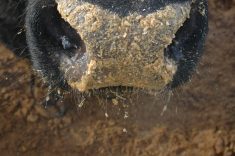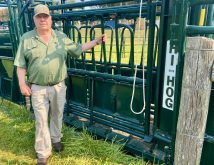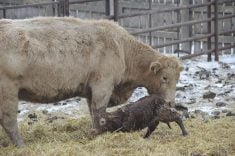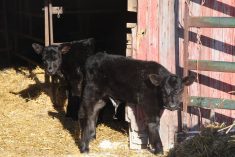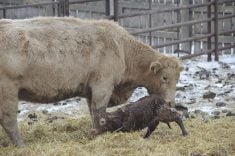The long-running cow-calf surveillance network provides data that cattle producers can use to see where they fit
REGINA — Updated indicators from a long-term project show that cow-calf producers are improving their production and management practices.
The Canadian cow-calf surveillance network, now known as the Canadian Cow-Calf Health and Productivity Enhancement Network (C3HPEN), has been monitoring animal health and disease, welfare practices and more since 2013. The project received renewed government funding for another five years to take it through to 2028.
Dr. Cheryl Waldner of the University of Saskatchewan’s Western College of Veterinary Medicine, who began this type of surveillance work 20 years ago, said the first five-year project was done only in Western Canada but expanded across the country for the second. It included 159 herds; 110 of those were in Western Canada.
Read Also

Feds propose overhaul of chronic wasting disease control program
Chronic Wasting disease control program getting updated by Canadian Food Inspection Agency with feedback encouraged from producers.
She outlined some of the productivity benchmarks for the top 25 percent of herds during a presentation at the Saskatchewan Beef Industry Conference.
The first indicator is length of breeding season.
“One in three people had a less than 63-day breeding season,” she said.
Open rates in this group averaged between 7.1 and 8.2 percent over 2019 to 2022, which is similar to the 2001-02 finding. Both time periods were affected by drought.
Abortion rates were less than two percent for both cows and heifers in most herds.
The percentage of calves dead within 24 hours was around one percent in the best 25 percent of herds. More calves are lost before weaning.
Producers assisted with calving less than they used to.
“We’ve gotten smarter in our old age,” said Waldner. “We’re buying bulls so that we don’t have to go pull calves, and we are doing much, much better. If you compare this to some of the data that I collected when I first started doing this 20 years ago, seriously, these numbers are about half.”
Pulls with calf jacks averaged 2.1 percent in both cows and heifers most recently, compared to 3.8 percent overall in 2001.
Waldner said variation of these measurements among producers can be addressed by some simple indicators, such as calving time.
“I can tell you that if you’re going to start calving at a different time of year, you’re going to have less trouble … but that’s not something most of us are willing to change or change very quickly,” she said.
The data shows people who calve earlier in the year have more trouble with infection and have to pay more attention to vaccine programs, herd management and nutrition to reduce their risk.
But those who calve later are also trying to breed cows later in the season and dry conditions in the past few years have made that more difficult.
“If I had been calving my cows so that I needed them to start getting pregnant in August, I would have been up the creek without a paddle the last couple of years,” Waldner said. “The point here is that the later calving herds have less calf loss but they have a lot more trouble getting their cows pregnant.”
The network collected blood samples from the cows in 2019 and the calves at weaning in 2021, which provided invaluable information, Waldner said.
For example, Johne’s disease was found in about one percent of the cows, but there was at least one positive animal in 17 percent of the herds. There is no vaccine or cure for Johne’s and it’s hard to eradicate once present.
There can be occasional false positives or concerns about blood tests. The study found the fecal PCR test better at detecting positive animals.
Waldner said the number of infected animals within most herds was not large, but producers should pay attention to the source of their replacements.
“The more we buy in cows, the more we meld them into our herds, the bigger herds get, the more likely this is to spread, so just a note of caution there,” she said.
A tool available on the Beef Cattle Research Council website helps producers determine how and when to test.
In terms of minerals, selenium deficiencies are down compared to 20 years ago, although they are still a problem in some areas.
“We still have some but it’s much more restricted because we’re doing a much better job of supplementing,” Waldner said.
In 2001, 10.6 percent of cows were deficient. That improved vastly to 0.4 percent in 2014 and was 0.2 percent by 2019.
Copper deficiencies were also less of a problem in tested herds. In 2014, 43 percent of cows were deficient and by 2019 that number was 29 percent.
Waldner said she questions why cattle are not responding to intense supplementation for copper as they are to selenium. Copper deficiencies can result in higher open rates.
She also said antimicrobial use in cow-calf herds hasn’t changed a lot since regulatory changes in 2018. Producers use them mainly to treat respiratory disease and diarrhea in calves, and lameness in adults. However, fewer than five percent of animals are treated in most herds.
Those who handle their cattle more in the spring run a higher risk of respiratory disease in their calves and she encouraged producers to pay attention to their vaccine programs and nutrition to improve immunity.
An examination of samples looking at antimicrobial resistance found producers are doing a good job. The industry is under scrutiny given the concern in human health.
“We’re seeing hardly any resistance in our cow-calf herds,” she said. “The overall frequency within herds is pretty low and for the most part we’re using these products when we need them.”
Waldner added that continued good data will help producers protect their social licence.
BVD virus was identified in just 0.2 percent of weaned calves due to strong vaccine programs.
The project identified that producers could do a better job of consistently vaccinating bulls and getting respiratory boosters into calves before weaning.




